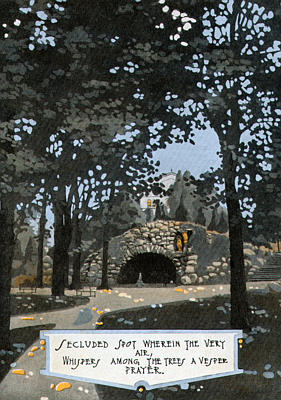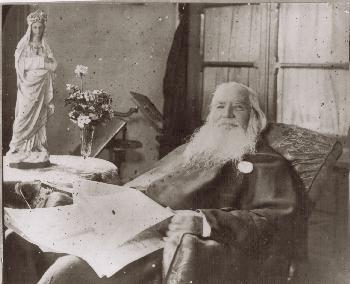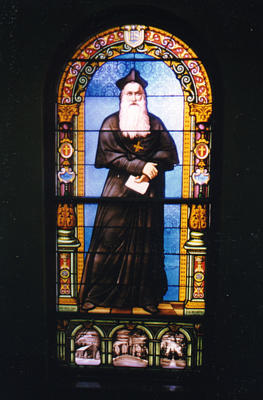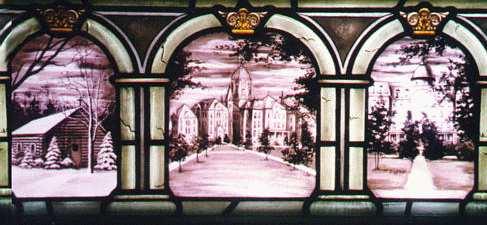
Notre Dame's Grotto / by Dorothy V. Corson


Planning Notre Dame's 1896 Lourdes Grotto
On October 31, 1893, All Hallows' Eve, "eve of all the holy ones' day," in the wake of declining health, Very Rev. Edward Sorin, C.S.C., founding father of the University of Notre Dame, took his last breath on earth.
Mother Ascension, who was devoted heart and soul to the interests of Father Sorin and Notre Dame, was with him. So was Father John W. Cavanaugh, who describes his last moments:

I remember seeing Father Sorin as he lay dying in his own bedroom attached to his suite on the first floor of the Presbytery. He was breathing heavily. His cheeks glowing with each recurring breath. There was little change in his aspect except that his eyes moved furtively about the room up and down and towards the side almost constantly. At the same time, I noticed that very frequently, even in his unconscious condition his gaze erected for a moment on the pretty little statue of the Blessed Virgin which had been set upon a small table at the foot of his bed. Those in the room were the venerable Mother Ascension, who had been such a true friend and helper to Sorin, Brother Columba, his faithful nurse during the months and years even of his illness, a little novice who was there to be useful in whatever way she could, and Father Zahm who held Father Sorin, literally in his arms, as he breathed his last.(115)
The University prepared for his funeral on All Saints' Day. He was buried on All Souls' Day. In his Chronicles , Sorin had noted with wonder the significance of his departure from France to "this new world" on the Feast Day of Our Lady of Snows in 1841. He would have been equally pleased that he departed from this life under similar significant circumstances.
In Notre Dame One Hundred Years , the author, Father Hope describes his funeral:
Archbishop Elder of Cincinnati preached the sermon. His words were a great comfort. He very likely exaggerated a bit when he said he did not "think that in all our country, nor in any single country, there is a place where one single man has transformed a savage wilderness into such a city of splendor and culture as this University of Notre Dame" he found a vibrant response in the hearts of his listeners. He made the most of the fact, also, that Father Sorin's death had occurred on the last day of October, a touching symbol, he said, of Father Sorin's two great devotions -- his confidence in the Blessed Mother to whom October is dedicated, and to the Poor Souls, for it was the eve of November that he had died.
. . . when all was ready the coffin was lowered into the grave. Only the autumn leaves, brown and rustling, whispered in the silence. He would have been eighty, they said, had he lived until spring. He was so great a man that no one, on that occasion, cared to think of his shortcomings.(116)
Timothy Howard speaks of the Sorin he knew in his later years:
The richest of all the gifts received by Fr. Sorin on this solemn Jubilee feast [1888] is that which Fr. Sorin has himself given to religion -- his own life. And this gift, like the grain of mustard, has grown, flourished, and sent forth leaf, bud, blossom, and fruit, until Notre Dame today is among the fairest of all the beautiful gardens planted in the wilderness of America.
The snows were now transferred to his noble brow, to his flowing beard, both worthy to adorn a prophet's head. Only the dark eye of genius, only the strong mental grasp, the immortal youthful hope and the childlike faith, marked him as the same courageous and far-seeing priest that had planted the cross in the wilderness, and beside the cross built up this dwelling place of religion, art and science.(117)

It would not be an exaggeration to conclude, that Notre Dame might not exist today without the distinctive personality and character of its founder and his unwavering faith in Mary. To the end, Father Sorin's whole being was focused on the Blessed Virgin. Notre Dame du Lac was everything to him because Our Lady -- the Mother of Goodness -- was everything to him. He was a man with a mission -- the keeper of the flame of her faith.

Father Corby accomplished what Father Sorin wasn't able to achieve, a more exact replica of the Grotto of Lourdes; a place of prayer and meditation for all who wander, by accident or design, into her presence on the Dome and at The Grotto.
The influence of Father Sorin's penchant for doing everything bigger and better has not been wasted on his successors. Each in his own way has carried on that tradition. Sorin was never one to do anything half way. He was always topping himself in honoring Our Lady. First the small bell was replaced with a huge one, the organ with a much finer one, the first church and main buildings with bigger and better ones; and the dome and its statue of our lady, with even larger versions.
How pleased he would have been to know that Father William Corby was about to carry on that tradition in building a bigger and better Grotto at Notre Dame, one that has so surpassed Sorin's that his has been literally forgotten. Nonetheless, Father Sorin was as responsible for the Grotto being there as if he had been on the scene, as he surely must have been, in spirit.